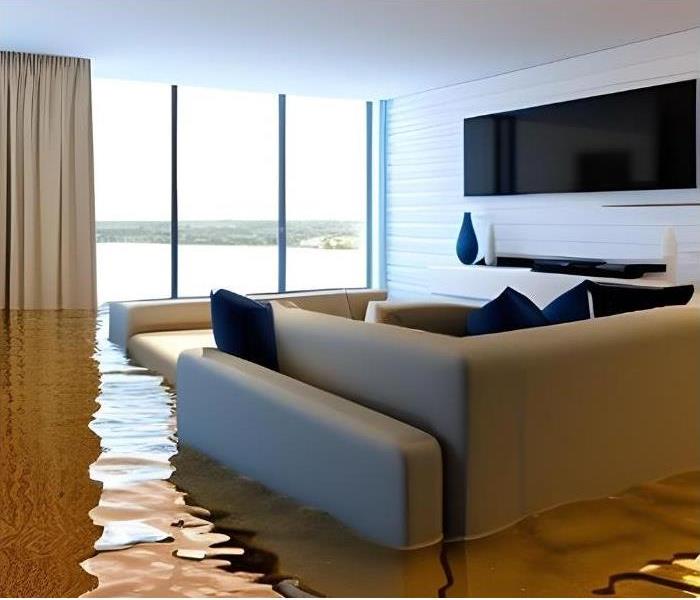The Comprehensive Guide to Understanding Water Damage Restoration Cost
8/17/2023 (Permalink)
Water damage restoration is a specialized process undertaken to repair homes and properties affected by severe water infiltration due to various causes such as flooding, pipe leaks, or natural disasters. The process involves several steps including assessment, water extraction, drying, cleaning, sanitizing, and finally, repair and restoration. It's crucial to handle water damage promptly to prevent further structural damage and mold growth.
Factors Affecting Water Damage Restoration Costs
Water damage restoration costs can vary greatly depending on several key factors:
- The extent of Damage: The more severe the water damage, the higher the cost of restoration. This can include the depth of water infiltration and the area affected.
- Type of Water: The source of the water can significantly impact costs. Clean water damage (from sources like rainwater or leaking pipes) is less expensive to clean up than gray water (water from appliances or showers) or black water (sewage or floodwater), which require more complex sanitizing services.
- Size of the Affected Area: The larger the affected area, the higher the restoration cost. Prices are often calculated per square foot.
- Location: Costs may vary based on the geographical location and the local cost of labor and materials.
- Mold Presence: If mold remediation is necessary, it can significantly increase the overall restoration cost.
Types of Water Damage and Their Costs
As touched upon earlier, the type of water causing the damage plays a vital role in the restoration costs:
Clean Water Damage
This originates from a source that doesn't pose substantial harm to humans. Common sources include rain, condensation, or a leaking pipe. Because of the lack of harmful substances, the cleanup process is typically simpler and less costly.
Gray Water Damage
This involves water that has a significant number of chemical, biological, or physical contaminants. Sources can include showers, sinks, and washing machines. Due to the additional contaminants, the cleanup process is more complex, increasing the cost.
Black Water Damage
This water is heavily contaminated and could cause health effects if ingested. It usually comes from sewage damage, flooding from rivers or streams, toilet overflow with feces, or stagnant liquid. This is the most costly to clean up due to the extensive sanitization required.
The Restoration Process
The water damage restoration process includes several steps:
- Assessment: The professional restoration services will first assess the type and extent of the water damage, which helps determine the cost estimate for the restoration.
- Water Extraction: The water is then removed from the property using powerful pumps and vacuums.
- Drying and Dehumidification: After all excess water has been removed, the drying process begins. This can take several weeks to complete and involves using equipment to remove any remaining moisture.
- Cleaning and Sanitizing: The area is cleaned and sanitized to remove any bacteria or mold. Personal belongings are also cleaned and sanitized.
- Repair and Restoration: The final step involves repairing structures or areas damaged by water. This might include replacing drywall, installing new carpets, and more.
Insurance and Water Damage Restoration
The role of insurance in covering water damage restoration costs can't be overstated. However, coverage can vary widely based on your specific policy. In many cases, insurance will cover damages if the cause was sudden and accidental. However, damage due to lack of maintenance or neglect might not be covered. It's always recommended to check your home insurance policy or speak to your insurance provider to understand your coverage.
DIY vs. Hiring Professionals
The decision to go DIY or hire professionals often boils down to the severity of the damage. For minor issues, a DIY approach might save you some money. However, a professional restoration company is equipped with the expertise and equipment to handle more serious water damage, ensuring all moisture is removed to prevent mold growth.
Choosing a Water Damage Restoration Company
Selecting the right water damage restoration company is crucial. Here are some factors to consider:
- Experience: The company should have significant experience in water damage restoration.
- Licenses and Certifications: They should be licensed and certified by recognized industry organizations.
- Local References: Look for local references or reviews to ensure the company provides quality services.
- Detailed Plan and Cost Estimates: A professional company should provide a detailed plan and transparent cost estimates.
Prevention and Maintenance
The best way to save on water damage restoration costs is prevention. Regular home maintenance like inspecting plumbing systems, maintaining appliances, and keeping your gutters clean can go a long way in preventing potential water damage.
Conclusion
Understanding the factors affecting water damage restoration costs can help you better navigate the process and make informed decisions should you ever experience water damage in your home or property.






 24/7 Emergency Service
24/7 Emergency Service
